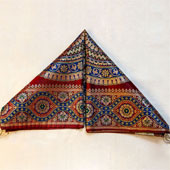Design Resource
Himroo Weaving - Aurangabad, Maharashtra
Art of Weaving Figure Fabric
by
Himroo word is originated from Persia, woven with pure gold and silver threads for royal families earlier.
Many weavers settled in Daulatabad near Aurangabad from Delhi when king Mohammad Bin Tughlaq shifted the capital and encouraged himroo craft. It is said that Aurangabad city was founded by Malik Ambar and during his reign people were fascinated to settle down in this place. Shawls preferred in olden days were himroo that used to cover the body. Mostly affordable by the Mughal rulers and Britishers made from pure cotton and silk. As raw material used is pure silk and cotton only few people prefer it due to the cost factor. Most of today’s Himroo shawls and sarees are mass-produced using power looms. As per the artisan, earlier himroo weaving was done on the double sided loom (locally called as the Pagar loom), Where minimum of two weavers were required, as a weaver and another to assist for interlacing the warp with the weft yarn. Many methods of fusing different materials like cotton with silk, cotton with artificial fibers and cotton with kela (Banana) silk were discovered due to the restriction of using pure silk.
Designs of the ajantha, ellora caves were taken as the reference of the pattern of design with which they still make the pattern. Today most of Himroo shawls and sarees are mass produced by the power looms, only few use their traditional looms. Himroo is an extra weft figure fabric with cotton and silk. It is ideal for stoles, shawls and furnishing material. Most of the designs that are found among them are like ovals, diamonds, circles, octagons, hexagons of geometrical shapes. Fruits like almonds, pineapple, pomegranate etc, flowers like jasmine, rose, lotus, birds, animals and designs of flowering creepers. Also floral inlay designs of Taj Mahal and Bibi ka Makabara.









